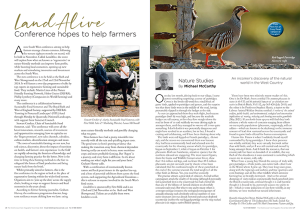
One day last month, driving back to our village, I came across something surprising: a covey of partridges. Covey is the lovely old word for a small flock of game birds, applied to partridges and grouse, and the surprise was that these birds were in the middle of the road, having presumably slipped in through the hedges at the side.
As our car approached them they took flight, but because partridges don’t fly very high, and because the roadside hedges are tall anyway, at first they flew straight down the road in front of us and suddenly we were driving right in amongst them, until they managed to swerve off: it was quite something. I don’t doubt it was potentially dangerous and might have resulted in an accident, but in fact, I found it exciting and exhilarating, and I have been thinking about why.
The birds were red-legged or French partridges, Alectoris rufa, and the reason we encountered them was because they had been commercially bred and released into the countryside for the shooting season which, for partridges, began on September 1, while it began on October 1 for pheasants. Both are handsome, attractive species; but the numbers released are staggering. The most recent figures, from the Game and Wildlife Conservation Trust, show that 11.6 million red legs, and no fewer than 49.5 million pheasants are put out each year by shoots: it has been calculated that the combined weight of these gamebirds at the end of the summer exceeds the total weight of all the other birds in Britain. Yes, you read that correctly.
The practice attracts a great deal of criticism. Animal welfare campaigners attack the cruelty of shooting (although I personally feel a gamebird shot in the countryside has had a better life than any of the billions of farmed chickens we cheerfully consume each year). But what to me and to many others is a stronger critique concerns the ecological consequences of annually releasing such absolutely colossal numbers of non-native creatures into our already battered and nature-depleted countryside (neither the red-legged partridge nor the ring-necked pheasant is in origin a native British species).
There have been two relatively recent studies of this. One is by Dr Mark Avery entitled The common pheasant: its status in the UK and the potential impacts of an abundant non-native in British Birds, Vol 112, pp 365-420 (July 2019) and the other is by Professor Stephen Harris, a report to the Labour Animal Welfare Society entitled A review of the animal welfare, public health, and environmental, ecological and conservation implications of rearing, releasing and shooting non-native gamebirds (May 2021). If you look them up you will find they both rehearse a whole series of concerns ranging from effects on our reptile populations (pheasants, surprisingly, will eat adders—which are known to be declining) to the immense amount of lead shot scattered across the countryside and found in game birds offered for human consumption.
I know this. I knew it when I suddenly found myself surrounded by flying partridges. I knew their presence was wholly artificial, they were virtually livestock rather than wild birds; and yet I was still excited and moved by being amongst them. And I think the reason is, that our countryside has been so denuded of its wildlife, that any flash of the abundance it once contained is something which causes me to rejoice, willy-nilly.
When I was a young boy I loved the coveys of truly wild, grey partridges—Perdix perdix, our native bird—that I saw in the Wirral where I grew up. They have long since gone, along with the lapwings and curlews and tree sparrows and corn buntings and all the other wildlife which intensive farming has so brutally destroyed. And so the annual dumping of sixty million commercially-bred gamebirds into the British countryside, artificial though it is and harmful though it is bound to be, perversely causes my spirits to lift—which is some indication of just how terribly, in my lifetime, we have trashed our natural inheritance.




